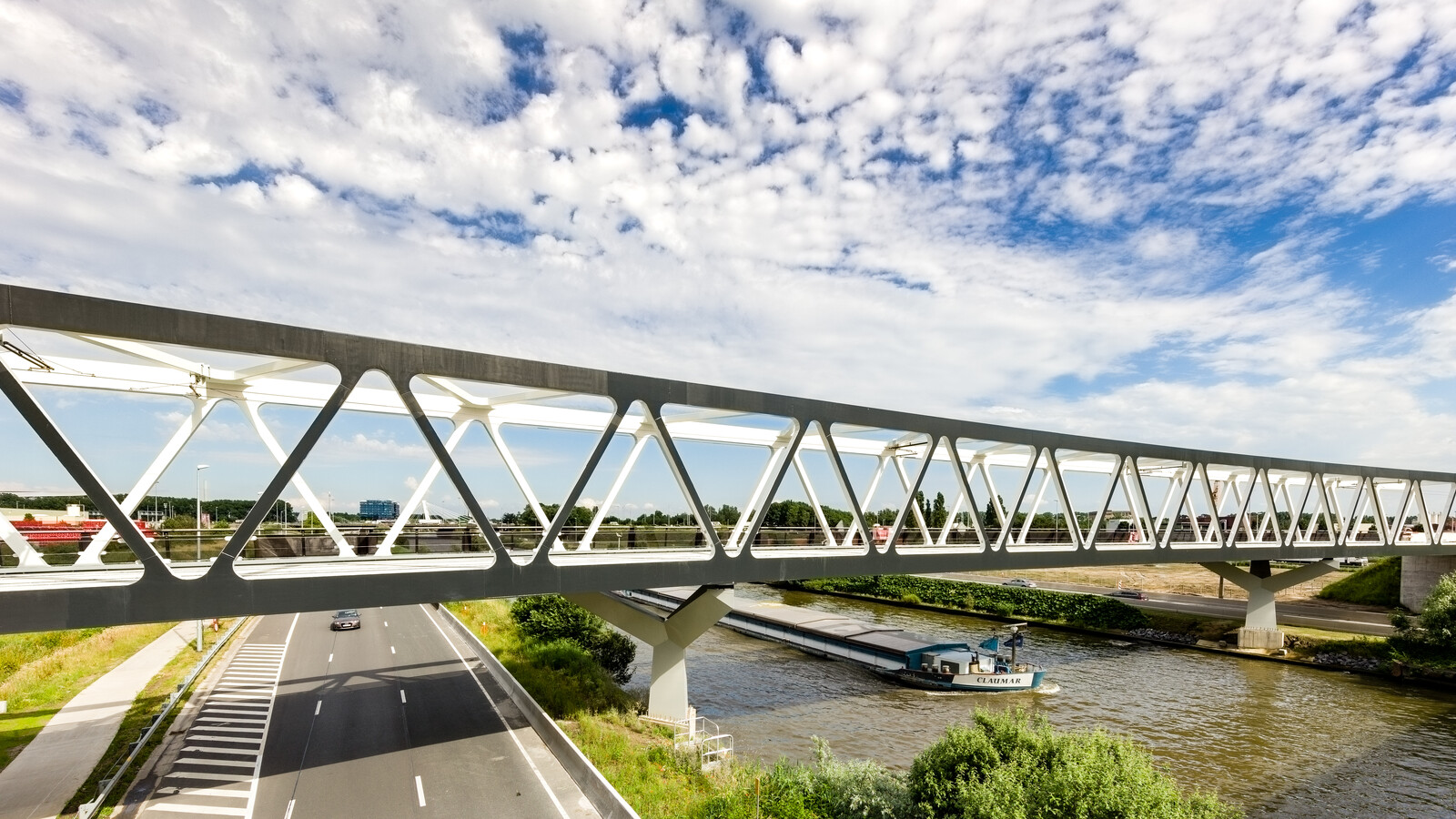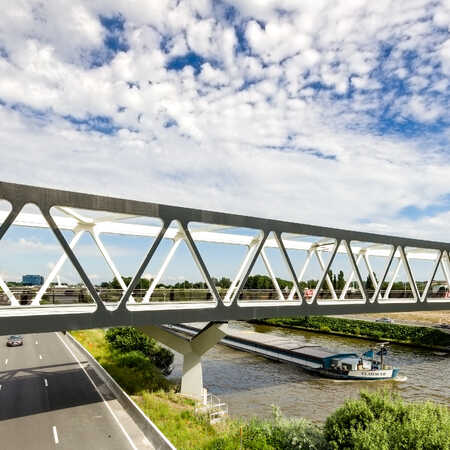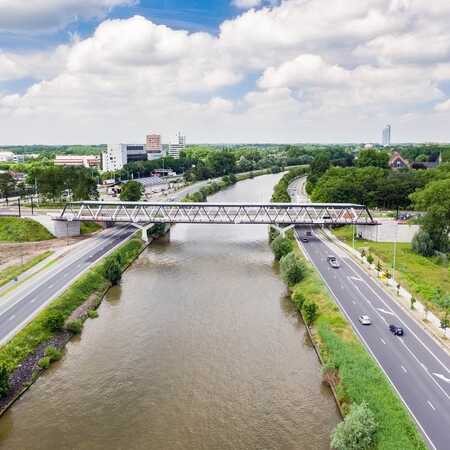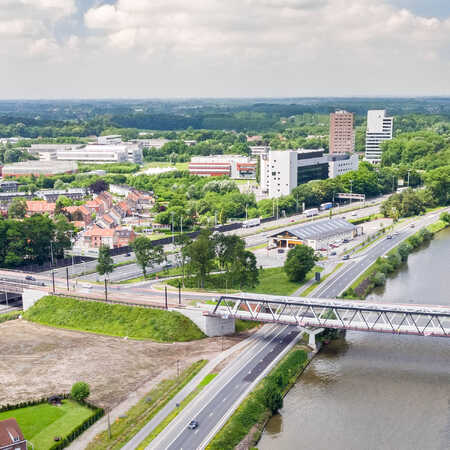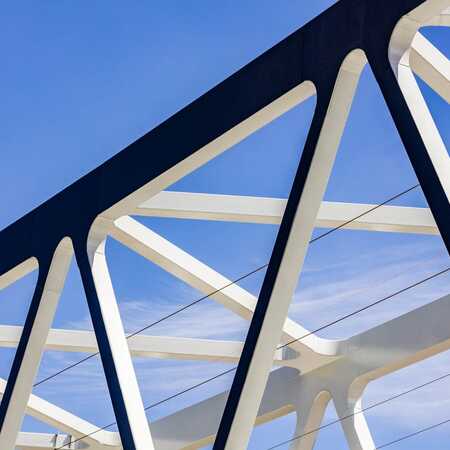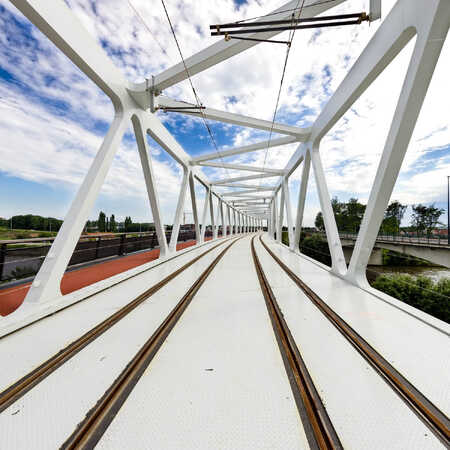Improving infrastructure
On the south side of Gent, the Ringvaart - a circular waterway around the city - separates the city and its industrial sites from the town of Zwijnaarde. This is also the location of a large motorway junction where the R4 ring road and the Brussels-Oostende and Antwerp-Kortrijk motorways meet. As part of the ambitious Flemish Pegasus program, plans were developed to improve the infrastructure of the city and the region, which included the extension of tram lines 21 and 22 across the Ringvaart and the E40 to Zwijnaarde. This plan required two tramway bridges with double tracks: the first crosses the circular waterway and the second is a continuation of the same tracks and goes across the E40 motorway. By way of a so-called cycling balcony, both bridges also accommodate cyclists to provide an extra bicycle connection between Gent and Zwijnaarde. Commissioned by Sweco Belgium, ZJA was responsible for the design of this project, which was completed in 2015.
Two very different bridges
Around the new tram bridges, two distinct landscapes with different characters can be observed. On the one hand, there is the infrastructural landscape between the residential centre of Zwijnaarde and the Ringvaart, where zones of greenery and shrubs determine the view between the busy ring road and the large motorway junction. On the other hand, there is the Ringvaart waterway, which the tram bridge crosses between a residential neighbourhood of Gent and an industrial area. This landscape is primarily structured by the waterway and its banks that form the median section between the two halves of the R4 ring road. The curved lines of the waterway dominate the experience of the landscape. Around Gent, a series of remarkable bridges have been built over the years. Of course, this bridge across the waterway should to live up to its neighbouring predecessors.
In response to these surrounding landscapes, ZJA has designed two starkly differing bridges. For the southern bridge that crosses the motorways, a neutral and austere design lies shoulder to shoulder with the adjacent bridge for car traffic, which makes it rather inconspicuous in its dedication to functionality. The bridge consists of two concrete abutments and an open railing in black steel. The real eye-catcher, though, is the following bridge that crosses the Ringvaart. It veers away from the car bridge and displays a visual quality that transcends its functionality.
Triangular truss
To fit into the collection of distinctive bridges laced around the city along the Ringvaart, ZJA created a striking design for this latest addition crossing the waterway. It stands out as the only truss bridge over the Ringvaart and because it is constructed entirely out of isosceles triangles. The pylons carrying the deck on either side of the waterway also have three arms and a triangular cross-section. It looks like a contemporary, slender version of a classical steel railway bridge, with the tracks embedded in the white steel deck.
However, there is a notable difference with old-fashioned steel truss railway bridges: this new bridge across the Ringvaart breaks free from the adjacent car bridge and crosses the water with a slight curving motion. As a result, the framework is modified with distinctive slanting lines. The curvature of the bridge provides a cyclist or tram passenger with an intriguing visual display caused by the alternating rhythm of the triangular crossbars as the framework bends sideways across the water. Viewed from the nearby car bridge, or from below from the R4 or the waterway, the image of a passing tram across the curved framework bridge is an attractive spectacle. The colours of the bridge enhance this effect because the deck and the insides of the steel trusses are white while the outside of the framework is black. This strengthens the three-dimensional visual effect of the bridge and its dynamic display of triangles, especially when the sun creates a second pattern of triangle shadows.
Architect: ZJA
Client: Vlaamse Vervoers Maatschappij De Lijn
Principal: Sweco Belgium
Jaar: 2016
Project: #533
Photos: Erwin Tecqmenne - Fototec
